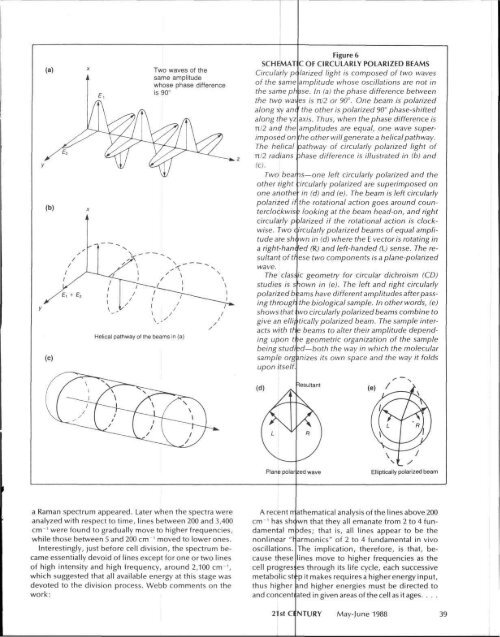The Geometry The Nucleus
The Geometry The Nucleus
The Geometry The Nucleus
You also want an ePaper? Increase the reach of your titles
YUMPU automatically turns print PDFs into web optimized ePapers that Google loves.
Helical pathway of the beams in (a)<br />
Two waves of the<br />
same amplitude<br />
whose phase difference<br />
is 90°<br />
Figure 6<br />
SCHEMAT C OF CIRCULARLY POLARIZED BEAMS<br />
Circularly pc larized light is composed of two waves<br />
of the same amplitude whose oscillations are not in<br />
the same ph jse. In (a) the phase difference between<br />
the two wax es is n/2 or 90°. One beam is polarized<br />
along xy am' the other is polarized 90° phase-shifted<br />
along the yz axis. Thus, when the phase difference is<br />
n/2 and the amplitudes are equal, one wave superimposed<br />
on the other will generate a helical pathway.<br />
<strong>The</strong> helical oathway of circularly polarized light of<br />
n/2 radians ihase difference is illustrated in (b) and<br />
(0.<br />
Two bear is—one left circularly polarized and the<br />
other right :ircularly polarized are superimposed on<br />
one anothe • in (d) and (e). <strong>The</strong> beam is left circularly<br />
polarized if the rotational action goes around counterclockwis<br />
: looking at the beam head-on, and right<br />
circularly p ilarized if the rotational action is clockwise.<br />
Two c ircularly polarized beams of equal amplitude<br />
are sh( >wn in (d) where the E vector is rotating in<br />
a right-hani 'ed (R) and left-handed (L) sense. <strong>The</strong> resultant<br />
oft! ese two components is a plane-polarized<br />
wave.<br />
<strong>The</strong> clasi ic geometry for circular dichroism (CD)<br />
studies is s Town in (e). <strong>The</strong> left and right circularly<br />
polarized b :ams have different amplitudes after passing<br />
through the biological sample. In other words, (e)<br />
shows that i wo circularly polarized beams combine to<br />
give an ellif tically polarized beam. <strong>The</strong> sample interacts<br />
with the beams to alter their amplitude depending<br />
upon fi >e geometric organization of the sample<br />
being studied—both the way in which the molecular<br />
sample org inizes its own space and the way it folds<br />
upon itself.<br />
a Raman spectrum appeared. Later when the spectra were<br />
analyzed with respect to time, lines between 200 and 3,400<br />
cm" 1 were found to gradually move to higher frequencies,<br />
while those between 5 and 200 cm -1 moved to lower ones.<br />
Interestingly, just before cell division, the spectrum became<br />
essentially devoid of lines except for one or two lines<br />
of high intensity and high frequency, around 2,100 cm -1 ,<br />
which suggested that all available energy at this stage was<br />
devoted to the division process. Webb comments on the<br />
work:<br />
A recent rr athematical analysis of the lines above 200<br />
cm -1 has sh( wn that they all emanate from 2 to 4 fundamental<br />
m >des; that is, all lines appear to be the<br />
nonlinear "r armonics" of 2 to 4 fundamental in vivo<br />
oscillations. <strong>The</strong> implication, therefore, is that, because<br />
these lines move to higher frequencies as the<br />
cell progres! es through its life cycle, each successive<br />
metabolic st ;p it makes requires a higher energy input,<br />
thus higher and higher energies must be directed to<br />
and concent ated in given areas of the cell as it ages. . . .<br />
21st CI NTURY May-June 1988 39

















